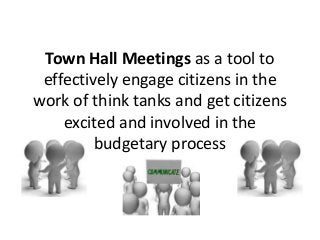Public Engagement: Town Hall Meetings in Armenia
Ordinary citizens often feel removed from the world of think tanks, not always fully understanding the work and research they do. This can lead to a lack of engagement by citizens in both the research and policy process, and lead to a lack of basic knowledge with regards pressing policy issues. The think tank I work for in Amenia, Advanced Social Technologies (AST), has sought to use mechanisms such as Town Hall Meetings to involve ordinary citizens in our work, and to solicit input and feedback on various topics. The presentation and video below describe our experiences and learning from these meetings. These meetings were conducted by in June 2012 in Armavir, Armenia. One of the meetings discussed policy alternatives for improving access of rural women to antenatal health services, while the other focused on policy options to improve the efficiency of public spending on drinking water. Each meeting accommodated 50 participants and examined different policy options, providing a wide array of different policy ideas that we could feed into our work - proving very valuable indeed!

Recomendados
Recomendados
Más contenido relacionado
Más de Research to Action
Más de Research to Action (20)
Último
Último (20)
Public Engagement: Town Hall Meetings in Armenia
- 1. Town Hall Meetings as a tool to effectively engage citizens in the work of think tanks and get citizens excited and involved in the budgetary process
- 2. What are Town Hall Meetings (THMs)? • A facilitated discussion among the general public, where hundreds of people get together and voice their specific concerns or suggestions on predesigned policy options to address the same policy issue. • An effective way for policy makers and policy researchers to get feedback from final beneficiaries AND engage them in the process of policy design.
- 3. What do you need to set up a THM? – the participants • First, decide who your participants are going to be. Does the policy concern everyone, or a particular group of people? • Once you’ve narrowed down your target group, find effective ways to invite participants to the meeting. These will be context-specific, and can range from personal invitations to leaflets handed out in the streets to media announcements
- 4. What do you need to set up a THM? – the logistics • A large room with tables that seat 10-12 participants • A facilitator and a note taker for each table • A laptop computer for each table connected via LAN to the main server • A simple software that allows notes taken at each table to feed into the server and be projected on a big screen in live fashion
- 5. What do you need to set up a THM? – the content Just two things: • A general-publicfriendly summary of the policy issue • A general-publicfriendly summary of 35 policy alternatives to address the policy issue and what the expected outcomes of the alternative would be
- 6. What do you need to set up a THM? – the human resources • Researcher capable of presenting the policy issue in a general-public-friendly manner • Facilitators who are well aware of the topic, but are capable of keeping their own opinions to themselves • Note takers who are capable of shaping the often incoherent thoughts into meaningful sentences and not missing any ideas in the process
- 7. How do THMs work? – Stage 1. Brainstorming Researcher presents the policy issue Facilitators either pass around or read out one of the proposed policy alternatives Participants give feedback to that particular policy alternative – both positive and negative! They then pass to the next policy alternative NOTE: You don’t compare alternatives at this stage!
- 8. How do THMs work? – Stage 2. Voting • After all policy alternatives have been discussed, every participant votes for the best policy option. • The results are logged in by the note taker and appear on the large screen
- 9. THMs - the many great outcomes • We now know how our policy alternatives resonate with the public and which of the alternatives is most likely to be well-received by the beneficiaries. You can’t lose! If our policy choice as researchers magically coincides with the public “vote”, we have a great leverage in our discussions with policy makers! If the option we were sure was absolutely best is voted worst, we know why and we can try to make it better!
- 10. Most importantly… A) The citizens start understanding what we are doing B) They feel part of what we’re doing C) And ultimately feel their voice may actually influence policy decisions
- 11. A fair warning • Let’s say the goal of your THM is to get feedback on a very specific budget decision within a small community and you’ve got the Community Leader on board who’s willing to go either way depending on the vote. In such a case, go ahead and tell the participants that their input will directly transfer into policy action. • In all other cases (99.9%), DO NOT make promises, or you risk ruining the A, B, C.
